

A Better Way to Learn AngularJS. Note: Looking to learn Angular 2?
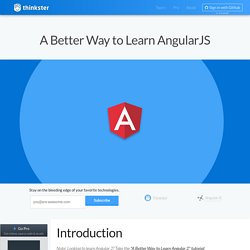
Take the "A Better Way to Learn Angular 2" tutorial Congratulations on taking the plunge! This AngularJS course is built with the intent of exposing you to the best available resources on each Angular topic. Our desire is to present these topics richly, and from a variety of vantage points, in order to afford you a more complete perspective on them. The learning curve of AngularJS can be described as a hockey stick. With AngularJS, the "Ready, Fire, Aim" learning methodology of duct taping together a handful of tutorials and a cursory glance through the documentation will lead to confusion and frustration. Prerequisites Resources Since AngularJS is still in its infancy relative to other JavaScript frameworks, the number of encyclopaedic resources on it is still insufficient. New to AngularJS 1.x? Start learning here. - Learn Angular 1.x.
AngularJS 1.x provides a lot of utility.
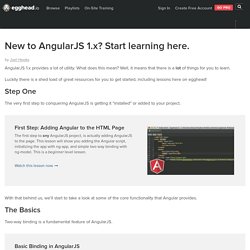
What does this mean? Well, it means that there is a lot of things for you to learn. Luckily there is a shed load of great resources for you to get started, including lessons here on egghead! Step One The very first step to conquering AngularJS is getting it "installed" or added to your project. With that behind us, we'll start to take a look at some of the core functionality that Angular provides. The Basics. Isaacs/node-supervisor. AngularJS — Superheroic JavaScript MVW Framework. Meteor.js - A web framework for everyone. First of all, I want to mention that no solution works everywhere.
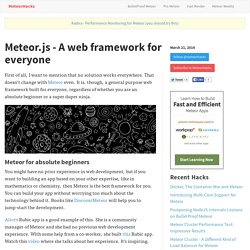
That doesn’t change with Meteor even. It is, though, a general purpose web framework built for everyone, regardless of whether you are an absolute beginner or a super duper ninja. Meteor for absolute beginners You might have no prior experience in web development, but if you want to building an app based on your other expertise, like in mathematics or chemistry, then Meteor is the best framework for you. You can build your app without worrying too much about the technology behind it. Install CentOS RedHat · dreamfactorysoftware/dsp-core Wiki. Prerequisites If you are upgrading an existing installation, you may skip this section.

How To Install Node.js on a CentOS 7 server. Introduction Node.js is a Javascript platform for server-side programming.
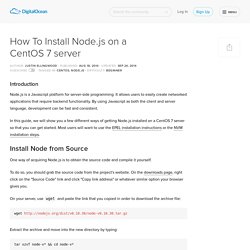
It allows users to easily create networked applications that require backend functionality. By using Javascript as both the client and server language, development can be fast and consistent. In this guide, we will show you a few different ways of getting Node.js installed on a CentOS 7 server so that you can get started. Most users will want to use the EPEL installation instructions or the NVM installation steps.
Install Node from Source. DreamFactory Blog. Dreamfactorysoftware/dsp-core. Https & authentication in node.js by Jeroen Moors. Belgian node.js User Group - 11/12/2013 Jeroen Moors I'm a freelance consultant. @ 475 71 42 49 Why do we need this?

What do we need? Identity Ensure Bob is the real Bob In a SSL world Privacy Encryption Ceaser shift Strong encryption using PKI Rules of the game Math glues primary and public keyPrivate key will ALWAYS be kept secretPublic key can be seen by anyone PKI in action - Public key exchange PKI in action - Encrypt and decrypt Authorization All men are equal What have we learned so far... Identity Server side: SSL Certificates Client side: ......................... Privacy SSL Certificates for encryption Authorization Certificate Initiation Install OpenSSL apt-get install openssl brew install openssl setup.exe ;) Getting Cirrius: Securing Node.js and Express with SSL Client-Authentication.
In the course of my work using Node.js, I did some research on implementing securing Node.js.
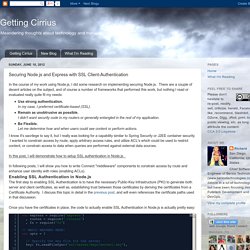
There are a couple of decent articles on the subject, and of course a number of frameworks that performed this work, but nothing I read or evaluated really quite fit my needs: Use strong authentication.In my case, I preferred certificate-based (SSL).Remain as unobtrusive as possible. I didn't want security code in my routers or generally entangled in the rest of my application.Be Flexible.Let me determine how and when users could see content or perform actions.
I know it's sacrilege to say it, but I really was looking for a capability similar to Spring Security or J2EE container security. I wanted to constrain access by route, apply arbitrary access rules, and utilize ACL's which could be used to restrict content, or constrain access to data when queries are performed against external data sources. Choosing your Node.js Authentication Strategy. Node is blowing up!
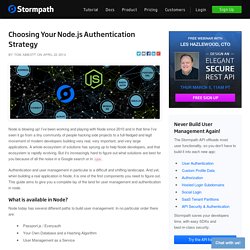
I’ve been working and playing with Node since 2010 and in that time I’ve seen it go from a tiny community of people hacking side projects to a full-fledged and legit movement of modern developers building very real, very important, and very large applications. A whole ecosystem of solutions has sprung up to help Node developers, and that ecosystem is rapidly evolving. But it’s increasingly hard to figure out what solutions are best for you because of all the noise in a Google search or in npm. Authentication and user management in particular is a difficult and shifting landscape. And yet, when building a real application in Node, it is one of the first components you need to figure out.
Underscore.js. Sails.js. Build a Complete MVC Website With ExpressJS. In this article we'll be building a complete website with a front-facing client side, as well as a control panel for managing the site's content.
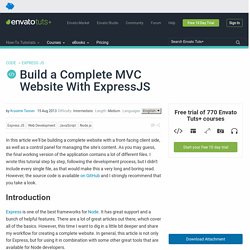
As you may guess, the final working version of the application contains a lot of different files. I wrote this tutorial step by step, following the development process, but I didn't include every single file, as that would make this a very long and boring read. However, the source code is available on GitHub and I strongly recommend that you take a look. Express is one of the best frameworks for Node. It has great support and a bunch of helpful features. I assume that you are familiar with Nodejs, have it installed on your system, and that you have probably built some applications with it already. A chatroom for all! Part 1 - Introduction to Node.js - Canadian Developer Connection. Node.js.